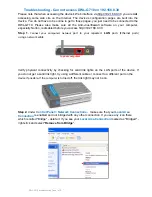
3: Evaluation Kit
XPort AR Integration Guide
23
LEDs
The LEDs on the XPort AR evaluation board provide indications of power on, RS-232 port
activity, and states of selected signals.
LED1 – LED4: Signal Monitoring LEDs
These LEDs are used to monitor the state of selected XPort AR signals. A signal selected for
monitoring is connected to an LED by placing a jumper wire between the signal’s pin in
header JP1 and an LED control pin in header JP2. These LEDs are driven by transistors. As
such, there is very little load placed on the observed signal. This allows the LEDs to be used
to observe a signal in a prototype circuit without affecting the circuit’s behavior.
LED5 – LED8: RS-232 Activity Monitoring LEDs
These LEDs are used to monitor activity on the RS-232 ports. These LEDs are driven by a
circuit that detects a low level on the transmit signals or receive signals and generates a
minimum length drive signal to the LEDS of a few hundred milliseconds. Since RS-232
signals are high when data is not transmitted, these LEDs are off when there is no activity.
Note:
These LEDs can be used as additional signal state monitors when the RS-232
transceivers are not being used. To accomplish this, jumper the signals to be
monitored to JP6-p1, JP6-p7, JP7-p1, JP7-p7.
LED9: Power LEDs
This blue LED illuminates any time the evaluation board is powered.
Test Switches
The test switches, SW1 and SW2 generate switchable high/low input signals to XPort AR
CPs that are configured for input. These are 3- position switches (on, off, and momentary).
When a switch is in the center position (off), it allows a pull-up resistor to create a high on the
corresponding header pin. When a switch is turned on, it connects its corresponding header
pin to ground. Each switch has a latched-on down position and a momentary-on up position.
These switchable signals are connected to the desired CP pin with jumpers placed between
JP3 and JP1.
Prototyping Area
The prototyping area provides 258 holes on 0.100” centers for addition of prototype circuitry
to the XPort AR evaluation board. Most of the holes are floating and available for any added
component lead to be placed in them. A few holes are pre-connected for convenience and
neatness of the circuit to be prototyped. These pre-connected holes have a thin-line
silkscreen boarder around them. These bordered groups of pre-connected holes are marked
with the reference designators PR1-PR5, GND and 3.3V.
PR1 is the group of holes adjacent to header JP1. Each hole in PR1 is connected to the
adjacent JP1 pin. When prototype circuitry is to be connected to an XPort AR signal, solder a
wire between the appropriate PR1 hole and the appropriate prototype circuit lead (or place
the prototype component’s lead directly in the PR1 hole). This keeps the JP1 pins available
for jumpers to LEDs or switches.
PR2 provides the same type of convenient connections to the observation LEDs for use in
prototype circuits.
Similarly, PR3 provides connections to SW1 and SW2.







































